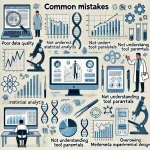
Unlocking the Power of NLP in Bioinformatics: Applications, Challenges, and Leading Tools
September 15, 2023NLP in Bioinformatics: A Guide to Applications & Challenges
Introduction
Natural Language Processing (NLP) is a fast-evolving field that facilitates interactions between human language and computers. It serves as a backbone for various applications, from machine translation to sentiment analysis. In bioinformatics, NLP has emerged as a potent tool for text mining, data retrieval, and even complex biological predictions. This blog explores the multiple facets of NLP in the bioinformatics space, detailing its applications, challenges, and the current state-of-the-art tools available for researchers.
Applications of NLP in Bioinformatics
Information Retrieval and Knowledge Discovery
NLP technologies have a profound impact on data retrieval in bioinformatics. They assist in sifting through vast scientific literature databases like PubMed to extract valuable insights on topics like protein-protein interactions or gene-disease relationships.
Prediction of Protein Structure and Function
Utilizing NLP methodologies, researchers can make accurate predictions about protein structures and their functionalities, providing vital data that could potentially revolutionize biological research.
Text Mining of Biomedical Data
NLP algorithms help in the mining of electronic health records (EHR) and scientific literature, transforming raw, unstructured data into structured, actionable insights.
Additional Applications
– Detecting noncoding RNA
– Standardizing biomedical nomenclature
– Large-scale mining of biological knowledge
– Analyzing DNA and RNA sequences
NLP and Protein Structure Prediction
Innovations in Prediction Techniques
Recent advancements in NLP have shown the potential to predict protein structure effectively. Leveraging the power of deep learning, specifically the Transformer model, these NLP models can process extensive repositories of protein sequences for accurate predictions.
Comparisons with Other Methods
While traditional methods like X-ray crystallography remain standard, NLP-based approaches offer a faster and often more cost-effective alternative. Compared to other machine learning algorithms, NLP has also shown potential in outperforming methods like Support Vector Machines in protein structure prediction tasks.
Challenges and Limitations
Linguistic and Terminological Issues
One of the key challenges is the inherent complexity and ambiguity of biological language, which sometimes hampers the accuracy of NLP algorithms.
Data Scarcity
A lack of labeled data for training NLP models is another stumbling block, particularly in specialized fields like bioinformatics.
Contextual Understanding
The complexity of human language poses challenges in contextual understanding for NLP algorithms, affecting their performance and reliability.
Overcoming Challenges: Strategies and Techniques
Utilizing Domain-Specific Ontologies
Structured vocabularies or ontologies can aid NLP algorithms in understanding complex biological terms.
Adoption of Machine Learning
Advanced machine learning algorithms can be trained to improve the accuracy of NLP applications in bioinformatics.
Creative Solutions
Collaborative efforts and innovative problem-solving can pave the way for optimized NLP applications in bioinformatics.
Top NLP Tools in Bioinformatics
– NLTK (Natural Language Toolkit)
– SpaCy
– Stanford CoreNLP
– Gensim
– TensorFlow & PyTorch
– Hugging Face
– Aylien
– IBM Watson
– Google Cloud
– Amazon Comprehend
Conclusion
Despite the challenges and limitations, NLP’s role in bioinformatics is expanding. Researchers are continuously striving to improve the algorithms and tools for more precise and scalable applications. With the burgeoning advancements in both bioinformatics and NLP, the future promises an integrated approach that could revolutionize both fields.
Related Keywords
– Natural Language Processing in Bioinformatics
– Text Mining in Biomedical Research
– Protein Structure Prediction
– NLP Tools for Bioinformatics
– Challenges in Bioinformatics
– Machine Learning in Bioinformatics
– Deep Learning in Bioinformatics
















